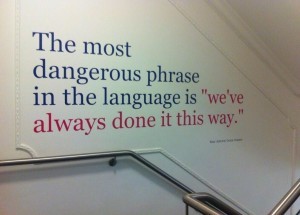POOGI for Police: An Introduction

What is POOGI?
The process of ongoing improvement. POOGI. Sometimes described as or considered in discussions surrounding continuous improvement, but regardless of the name or acronyms, its found in the most successful companies and corporations. Lean, Six Sigma, the Theory of Restraints, green belts, black belts; perplexing terms and references until they are explained and brought into focus. In the end, it’s all about improving efficiency and reducing waste. POOGI is traditionally associated with manufacturing processes, but it can easily be applied to service industries, which of course includes policing.
Where does POOGI fit in with Policing?
For policing, POOGI will mean finding out what is in the way of getting things done and fixing the problem. This is an over simplification of how it works, but for most of us, it describes what we have felt and observed intuitively during our careers. We write off having to wait on some things to ‘red tape’, seeing good ideas fall on deaf ears because of ‘that person’ that seems to always set a ceiling for ideas. The best excuse, of course, will always remain running in circles and redundant tasks ‘because we’ve always done it this way’. We know it can be done better, but how do we get there? It’s a process, sometimes not easy, but attainable.

Examples?
Some examples where a department might look for improvement and explore POOGI include:
- Hiring: Is the hiring process timely, or are good candidates drifting away to other police departments because your department’s process is dragging on and on?
- Call Response: Are your PSAPs and patrol functions optimized individually enough to work well together and facilitate reasonable responses to non-priority calls?
- The Service Counter: Is the community (your customers) serviced effectively and expediently when they come in for reports, answer to questions or other services your department provides?
- Case Investigations: No department will ever have the staffing it actually needs, so time management is critical. Have you ever asked your investigators what gets in their way of clearing cases?
- The Budget and Overtime Costs: Sometimes overtime is actually money well spent, sometimes it is not. Does your agency know how to tell when it is avoidable and what drives it?
These questions just scratch the surface. The processes that lead to improvement will go much deeper and take the form of a meticulous analysis of the procedures, policies and capabilities of those performing the tasks involved, as well an assessment of equipment and technology that is in use.
So?
Does your agency participate in a POOGI? Does your local government? Successes? Failures?

Doug “Red” Parker
Retired Law Enforcement officer
A good beginning. Our profession can learn much from business models. My belief is that police management systems are rigid, hierarchical and restrict communication and innovation. I do not propose to throw out the entire system. However, functionality and communication across traditional barriers need to be promoted in managements systems instead of “career development”, which is typically learning how to promote to the next level. Successful private enterprises embrace ongoing improvement through a variety of practices. Law enforcement can do the same.
Evidence-based testing for promotion would change the ways candidates prepare. Instead of taking courses in how to succeed in an assessment center, they should be honing their skills in communication, emergency preparedness, critical thinking and mentoring. And in order to promote, they need to present hard evidence of their skills in these (and other) areas.
Fred Leland
How true are those words.
James Barth
Excellent article David. I think POOGI is a much needed process throughout the Law Enforcement community. I agree with you that too many agencies / departments think like you mentioned that this is the way we have always done it and this the way we’ll continue to do it. Times have changed, and we must change with it.
While I agree that “because we’ve always done it this way” is frequently an obstacle to improvement, let’s not forget we often do things for valid reasons.
True. I would never advocate change for change sake. Internal policy is responsible for most system constraints, so taking a look at them from time to time is not a bad idea.
Robert Chapman
Interesting concept, HORRIBLE CLASS TITLE!
Steve Borris Consultant and Author
David
Good article.
Continuous improvement will work for any service – although I suspect the criminal side of policing might have some really complex process maps – simply because (in politically correct speak) bad people might not tell the truth, which will complicate decision making.
I do like (as seen on TV) the use of visuals like real timelines. Interestingly, I like mind mapping for my own notes, but feel the “family tree” of pictures does not help me much.
For the admin work, lean is pretty much a given and, I would suspect, some stuff like (people) OEE would be helpful to determine capacities.
I have recently had an American Police Captain join my network and I hope to learn how they apply lean – as I would also like to know how UK departments use it.
There are a number of complications that implementing lean for tasks “in the field” would create – locations and traveling being only two of them.
But it would be interesting to map the processes and find the opportunities for improvement.
Steve
David Lyons, MBA
Thank you for taking the time to comment; the War Room is a place I am hoping to get comments on as I include this topic on my blog. I agree that a wholesale implementation of lean would be difficult for the reasons you mentioned. I think that there is room for it to work its way in, even if a little at a time (knowing that is not the preferred approach). I recently saw a presentation where Colorado Springs police were engaged in some functions by the local government and found some successes.